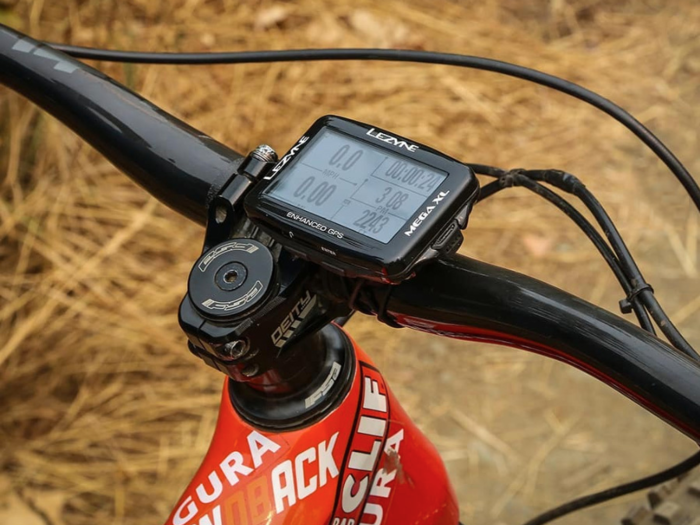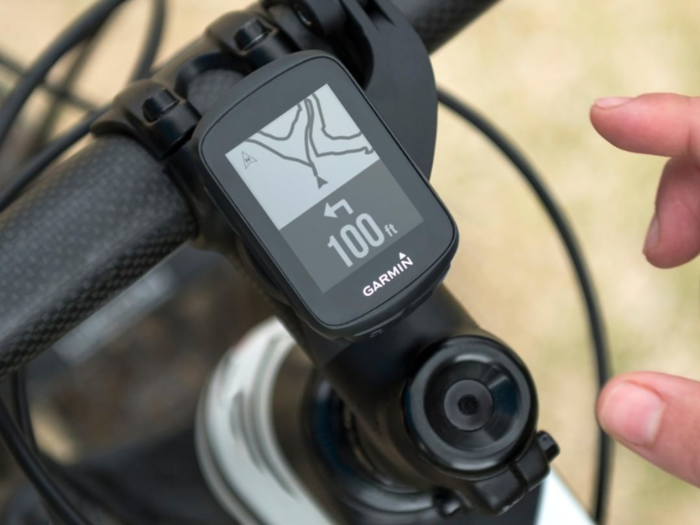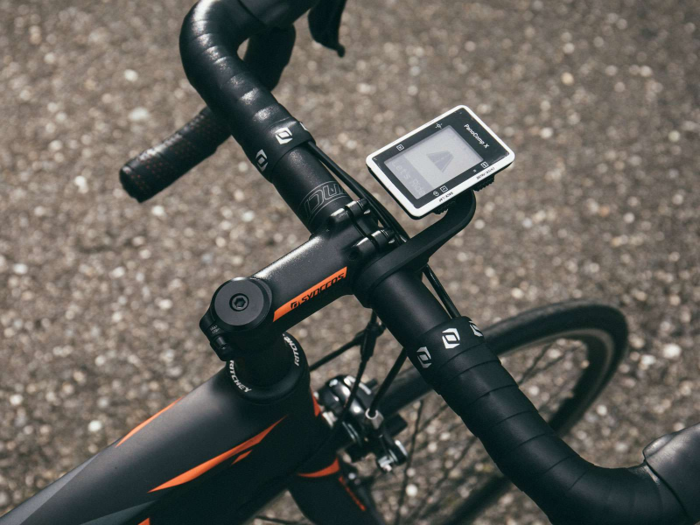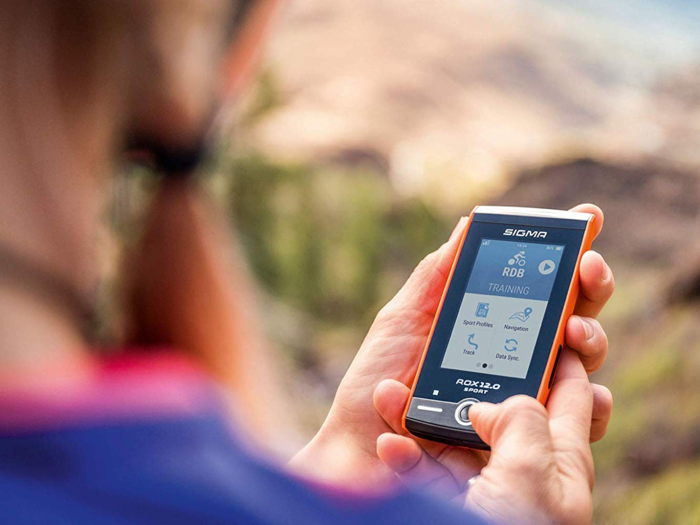- Home
- slideshows
- miscellaneous
- The best GPS bike computers you can buy
The best GPS bike computers you can buy
The best bike computer overall

The best bike computer for bikepacking and touring

Nothing is more frustrating than having a map on your device that you can’t quite orient to see if the road you want to take is going to connect you to incredible riding or leave you lost in the middle of nowhere. You zoom in and you can see the road, but you zoom out, and it disappears. You ride down it, get stuck at the bottom of a big hill, and curse the GPS as you haul yourself back up the other side wishing you’d just stuck to paper maps instead of this high-tech nonsense. Then the damn thing runs out of battery.
The Mega XL won’t leave you stranded. The incredible 48-hour run time, combined with the fact that the device can be charged whilst it runs, means that even the most extreme exploring will be recorded on the device’s spacious internal hard drive. Its 2.7-inch high-resolution screen can be run in portrait or landscape mode so you can always see where you’re going and, provided you download maps before heading out, how to get home.
Much like the reviewers at road.cc, I really liked the positive engagement and secure locked-in feel of Lezyne’s 1/8 turn mount. Lezyne also offers a mount that places the light directly in front of the stem and incorporates a mount for a camera or light. The unit is slightly larger, thanks to its big screen and battery, which makes this secure interface even more valuable.
In months of use, the only glitch I found was one ride where the altimeter suddenly began racking up tens of thousands of feet of climbing that I hadn’t done that day. Lezyne’s engineers know such bugs exist with an GPS chip, and engineered an altitude correction into the device’s upload portal, thus robbing me of the record-beating Strava kudos I had been planning to receive for my epic ascent.
Another great piece of software engineering is the Lezyne track function that sends my wife an email whenever I start a ride and updates her on my location using my linked cellphone. It’s also great to be able to read and dismiss calls, texts, and other alerts right from the Mega XL’s huge screen, although I found customizing these alerts a little more challenging than in the Wahoo app.
The included app is generally pretty useable, although uploading of rides is manual rather than automatic as with the Wahoo. Many coaches prefer this as it gives riders a chance to enter their training notes. Amazon reviewers liked that the Mega XL showed the battery levels of all connected sensors.
Setup via the Lezyne app was generally simple, although some users were frustrated by frequent firmware updates. I didn’t find these too burdensome, although forgetting to download a map that covered the edges of one bikepacking trip was frustrating, but largely my own fault. I loved leaving the Mega XL on my bikepacking bike and being able to keep tabs on where I was, the charge state of all my connected devices and my distance covered.
I tended to use the Mega XL in landscape mode, perhaps because it reminded me of the old SRM head unit that I once raced with. In this orientation, the Mega XL displays menus in portrait mode. It’s little glitches like this that keep the Lezyne from taking top honors. It offers great value, all the functions of the best computers tested, and best-in-class battery life and navigation.
If you’re looking for a bikepacking computer that reliably delivers the functions you want, the Mega XL is great, but it lacks the finesse of some of the other products here.
Pros: Huge screen, incredible battery life
Cons: Maps need to be downloaded, out-front mount sold separately
Buy the Lezyne Mega XL on Amazon for $199.99The best bike computer for data nerds

I remember when the Nintendo 64 launched with the tagline that it was more powerful than the computer that put man on the moon. These days that’s not that remarkable, but when you consider that a dozen years ago, people were still riding with magnetic bike computers that they had to manually input wheel diameters into, the Edge 1030 is nothing short of miraculous.
The technology in this head unit rivals that of a laptop and there’s nothing it can’t tell you about your training or route. For people who love tech and data, this will be the perfect head unit.
The 1030 works via a combination of buttons and a touchscreen, the former can be a little hard to access when using an out-front mount, and the latter can be a little frustrating when trying to access data whilst riding at 25 miles an hour. I did find that the 1030’s touchscreen responded much better to gloves, sweat, rain, and dust than previous units, but compared to the Sigma, I accessed the wrong page more often on the Garmin.
Certainly, with all that data literally at my fingertips, it was fun to swipe through and see everything from left/right balance to training load and recovery time. Data such as weather information isn’t available on other computers that we tested and proved genuinely useful in my testing.
Other notifications were less useful (I don’t need to know when there is a sharp corner coming up, I can see it and I am trying to pay attention to steering around it), but could easily be turned off on the device, or using Garmin’s excellent app.
I did find that the Garmin crashed once or twice, something that less complicated computers never do, but the sort of rider who wants a bike computer that tells them their projected recovery time as soon as they finish a ride will understand that this requires more delicate electronics.
The Edge 1030’s navigation features are excellent and are only challenged by the Sigma Rox 12.0. Not only can you browse the full color map for places of interest, you can also see routes based on user generated data to ensure you take roads cyclists prefer, which usually means safer routes.
I tested this in downtown LA, and I’m here to tell the tale, which is a ringing endorsement indeed. I also enjoyed being able to navigate to points of interest, because I didn’t even have to stop riding to find the nearest café.
Road.cc testers did note that you’ll need to check longer routes as those generated can be a little bizarre, but I found that most of the time I navigated with the 1030 it did a great job of finding me a safe way home. A satisfied Amazon buyer noted that the powerful processor and connected cellphone app allows for the Garmin to auto upload rides to online platforms like Strava and easily configure screens and setup.
Now, is it worth $600? Only you can decide that. It does come with an out-front mount, so at least you won’t have to shell out anything extra to set it up on your bike. If you plan on navigating with your bike a lot without uploading routes, the Garmin and Sigma units are leaps and bounds ahead of the competition.
Features like weather reporting and clean app integration set the 1030 apart from the Rox12.0, and both use the same mount and Micro-USB charge cable, so if you feel the extra features justify the extra price tag you certainly won’t be disappointed with the Garmin 1030.
Pros: Incredible data analysis, colour screen, navigation based on where cyclists ride, touchscreen
Cons: Touchscreen, expensive
Buy the Garmin Edge 1030 on Amazon for $599.99The best bike computer for value

The Panocomp X makes use of the pocket computer many of us already carry around for a lot of its functionality. By outsourcing much of its processing in this way, the Panocomp X delivers much of the functionality of more expensive computers for a fraction of the cost. Should you find yourself soul riding without your phone, the Panocomp X can use a speed and cadence sensor to make sure you still get your training information.
The Panocomputer is easily mounted on the handlebars and sits in front of the stem for easy and safe viewing. It does use a proprietary mount which is slightly frustrating. I have a drawer of Garmin/Sigma and Wahoo mounts, but I had to move the one supplied out front mount across bikes to use the Panocomputer on road and mountain bikes. It also comes with a stem mount, but I prefer not to use those.
Once on the bike, I connected the computer via Bluetooth to Topeak’s Panobike app. This app then sent GPS data such as speed and distance to the bike computer. Indeed there is an option to run the app on your phone and do away with the computer head unit altogether, but I’m not a big fan of placing my phone on my handlebars where it can be damaged.
The computer can also run using the supplied speed and cadence sensor if you don’t wish to rely on your phone. In practice, the latter is a better idea, as my iPhone 8 provided pretty inaccurate GPS data when I tested the Panocomp side by side with the other computers on test.
The three available screens are plenty for the data available, which is admittedly much less than the array offered by some computers. Although some will miss this, metrics such as speed, distance, heart rate, and cadence will be a enough for many riders. Unlike the other head units on test, the Panocomp doesn’t offer ANT+ connectivity, which means power meters and existing heart rate accessories won’t work.
Navigating the data fields on the clear and well-lit screen is accomplished by buttons on the side of the device that I found required quite a lot of force to press. This helps when wearing gloves, but did mean I missed a button sometimes.
The unit charges via a proprietary charge cable that magnetically attaches to the back of the computer. Although this works well, it can be annoying if you forget the cable on a trip. At least if this does occur you can run the companion app. The app does let you export rides to Strava, but I couldn’t find a way to do so automatically.
The Panocomp does offer better value than anything else we have tested, but it lacks features like uploadable workouts, mapping and directions, and built-in GPS. If you have the budget, the Wahoo does just about everything most riders need for about $80 more, but if you are just getting started or you know where you’re gong and want to keep track of and share your rides, the Panocomp is a great budget pick.
Pros: Great value, covers basic functions well
Cons: Won’t connect to power meters, lacks navigation, proprietary everything
Buy the Panocomp X at REI for $126.73 (originally $169.95)The best bike computer for navigation

Sigma made a name for itself with some of the best wired cycle computers around, and its latest offering is a much updated but equally reliable computer that packs as much functionality as more widely hailed brands. What Sigma did wisely was take its expertise in making bike computers and let other brands do what it doesn't do: design an operating system. The Rox 12.0 runs on Android, and is every bit as fast, clean, and clear as the cellphone that many of you are reading this on.
If you plan to use your bike computer to navigate in areas you don’t know, the Rox or the Garmin are really your best bet. Amazon shoppers liked the accuracy and visibility of the maps provided and so did I. Sigma obtains its base maps from the OSM (OpenStreetMap) database, so the directions should be accurate and up to date. The maps are continually refined and updated and those for the USA and Canada come pre-loaded on the device with other regions available at no cost.
Some maps on other computers can’t be zoomed or moved, which means that if you want to see where a road goes or how to get home you have to stop and pull out your phone. With the Rox 12.0, I could see a road, quickly skip to the map page on the computer, and decide if I should take it or not.
As DC Rainmaker notes, the responsiveness and clarity of the maps on this device is fantastic, I don’t normally use maps on GPS head units unless I have a route uploaded but the Rox 12.0 changed that. I plugged in destinations or searched for them as I would on my phone and was able to discern the route easily, even in bright sunlight.
The Rox 12.0 can be customized with colored cases to match your bike or kit. The bright colour screen works well in all light conditions and we found it easy to customize screens to show exactly what we wanted to see on rides using Sigma’s desktop software or using the device itself.
Of all the devices we tested, this one had by far the most screen clarity and an incredible touchscreen that worked as well as a smartphone even when riding with gloves in the rain, but should you prefer, the device also offers side buttons to switch screens.
Sigma made a wise decision to use the same mount as a Garmin and other industry players to allow users to take advantage of a variety of aftermarket mounts, which integrate accessories such as lights and action cameras. Indeed, Sigma provides a mount from Barfly, although it carries Sigma branding, that allows for a light or camera to be run beneath the computer. This is a nice touch in a computer at this cost. The unit also charges via Micro USB, which means you’ll never have to be without a cable even if you’re touring or traveling.
My only real criticism is not of the unit itself, but of the app that comes with it. In testing dozens of bike computers, I actually found I preferred not to pair them with my phone as the notifications became annoying when I was trying to enjoy a bike ride, but should you prefer to know who is calling or texting, the Sigma is not capable of cellphone connection and showing notifications.
In time, I am sure this will be changed, but for now all ride data is uploaded by Wi-Fi. Obviously this is not a cheap bike computer, and that will be a negative for some, but given that it delivers navigation features for which we normally rely on a phone that costs twice as much, it’s hard to argue that the Rox 12.0 doesn’t present good value for someone who will make use of its full feature set.
Pros: Incredible clarity and precision touch screen, great navigation
Cons: Expensive if you don’t need all the features, app isn’t great
Buy the Sigma Rox 12.0 on Amazon for $475Popular Right Now
Popular Keywords
Advertisement